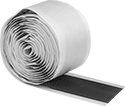About Heat-Shrink Tubing
More
Wrap-Around Heat-Shrink Tubing
Protect wire and cable without disconnecting them from an assembly. This tubing is ideal for adding protection to damaged components that are hard to rewire. For a water-resistant seal, it has an adhesive lining that melts when heated to bond the tubing to the underlying surface. It meets ASTM requirements for flame retardance.
Tubing with an adhesive strip closure is easy to install. Simply peel off the paper backing, wrap the tubing around your components, seal the adhesive strip, and shrink it. Use this tubing to protect smaller components or bundles of wiring. It meets military specifications for material quality and color.
Tubing with a locking channel closure gives you more secure protection than tubing with an adhesive strip closure. It’s ideal for protecting larger components in applications that demand a strong seal, such as industrial construction and automation systems. To install, wrap the tubing around your components and insert the stainless steel locking channel to hold the tubing together. Then shrink the tubing from the center to the ends. After shrinking, you can leave the locking channel on or remove it, depending on your application.
Dielectric strength is the maximum voltage a material can handle before it starts to breakdown.
ID Before Shrinking is a minimum value and may be larger than published.
For technical drawings and 3-D models, click on a part number.

- Material: Polyolefin Plastic
- Shrink Ratio: 3:1
- Dielectric Strength: 500 V/mil
- Shrink Temperature: 250° F
- Temperature Range: -65° to 230° F
- Specifications Met: ASTM D2671, MIL-DTL-23053

- Material: Polyolefin Plastic
- Shrink Ratio: 3:1
- Dielectric Strength: 350 V/mil
- Shrink Temperature: 250° F
- Temperature Range: -30° to 210° F
- Specifications Met: ASTM D2671
ID | 8" Lg. | 3ft. Lg. | |||||
|---|---|---|---|---|---|---|---|
| Before Shrinking | Min. After Shrinking | Min. Wall Thick. After Shrinking | Color | Each | Each | ||
| 1.7" | 0.4" | 0.09" | Black | 0000000 | 000000 | 0000000 | 000000 |
| 2.95" | 0.6" | 0.1" | Black | 0000000 | 00000 | 0000000 | 000000 |
| 3.7" | 0.98" | 0.1" | Black | 0000000 | 00000 | 0000000 | 000000 |
| 5.4" | 1.34" | 0.1" | Black | 0000000 | 00000 | 0000000 | 000000 |
| 6.3" | 1.65" | 0.1" | Black | 0000000 | 00000 | 0000000 | 000000 |
| 7.8" | 1.89" | 0.11" | Black | 0000000 | 00000 | 0000000 | 000000 |
Moisture-Seal Wrap for Heat-Shrink Tubing

Use this wrap with heat-shrink tubing to create a moisture-resistant seal. Apply it like tape around wire and cable, and slide the tubing over the wrap. The wrap melts when tubing is heated and bonds to the underlying surface.
TPE rubber wrap has a higher dielectric strength than nylon plastic and butyl rubber wrap, so it’s the best choice for electrical insulation.
Nylon plastic wrap is ultra thin, so you can wrap it around each individual wire as well as your whole bundle for enhanced protection. Along with water, it resists oils, chemicals, and grease.
Butyl rubber wrap seals larger gaps than TPE rubber and nylon plastic wrap, so it’s better for protecting irregular shapes or items with deep grooves. However, it doesn’t withstand temperatures as high.
Dielectric strength is the maximum voltage a material can handle before it starts to breakdown. The higher the dielectric strength of a material, the better it is for preventing electricity, heat, or signal from dissipating from wire and cable.
| Thick. | Wd. | Color | Clarity | Temperature Range, °F | Dielectric Strength | Each | |
1 ft. Lg. | |||||||
|---|---|---|---|---|---|---|---|
TPE Rubber | |||||||
| 0.026" | 1" | Yellow | Semi-Clear | -65° to 245° | 500 V/mil | 000000 | 00000 |
Butyl Rubber | |||||||
| 0.062" | 1" | Gray | Opaque | -40° to 190° | 250 V/mil | 000000 | 0000 |
5 ft. Lg. | |||||||
TPE Rubber | |||||||
| 0.026" | 1" | Yellow | Semi-Clear | -65° to 245° | 500 V/mil | 000000 | 00000 |
Butyl Rubber | |||||||
| 0.062" | 1" | Gray | Opaque | -40° to 190° | 250 V/mil | 000000 | 00000 |
25 ft. Lg. | |||||||
Nylon Plastic | |||||||
| 0.008" | 2" | Yellow | Semi-Clear | -65° to 275° | 300 V/mil | 00000000 | 000000 |

























